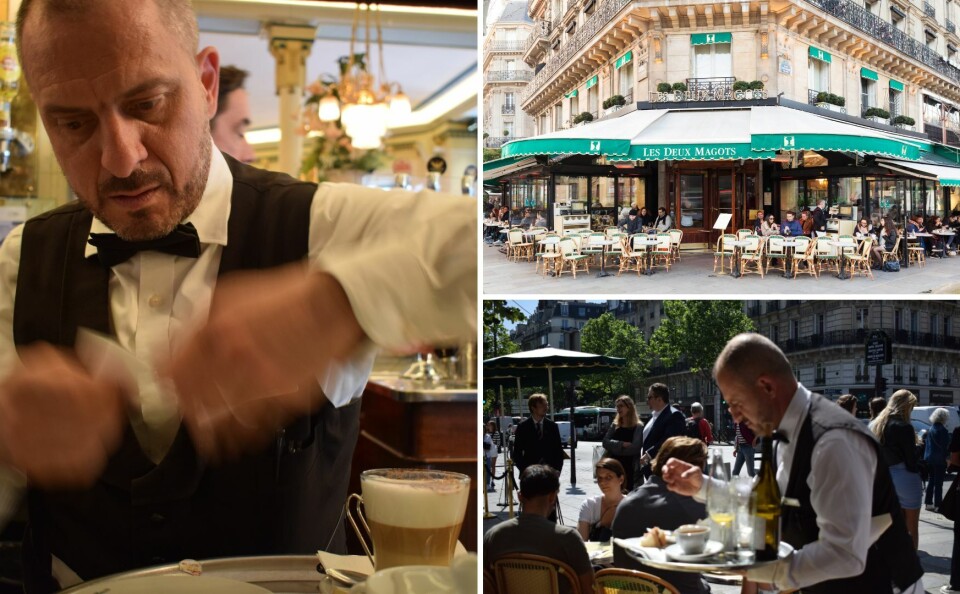-
Grand crème, café crème, au lait: how to order coffee in France?
We explain the subtle distinctions between the various terms used in cafés
-
Fines for driving in central Paris delayed until September
‘Educational period’ to be extended with drivers only cautioned for breaking rules
-
Paris pledges action against voyeurs in public swimming pool changing rooms
It comes after several women came forward to report similar sexual assaults
Les Deux Magots: Behind the scenes at one of the best cafes in Paris
Actor-turned-waiter Kévin Meyer on famous customers, the iconic uniform and how American conventions are gradually slipping in

Kévin Meyer fell into the restaurant industry as a means to pay for his theatre studies.
Little did he know he would turn the brasserie floors into his own stage, especially after landing a role at one of Paris’s most prestigious cafes.
Hemingway and Sartre
Mr Meyer has been a garçon de café for seven years at Les Deux Magots, where the intelligentsia sits, eats, sips and, since 1933, gathers for one of France’s biggest literary prizes, the Prix des Deux Magots.
The cafe is located in the Saint-Germain-des-Près district and is among the three most renowned cafés littéraires in France, along with nearby Brasserie Lipp and Café de Flore.
Literary heavyweights including Ernest Hemingway, Jean-Paul Sartre and Simone de Beauvoir have all counted among ‘regulars’, and their custom is immortalised via signature breakfasts on the menu, pictures hanging on the wall, or plaques signalling where they usually sat.
‘Like a show’
Mr Meyer, 44, dons the traditional black-and-white waiter’s outfit to serve modern-day celebrities and tourists alike.
He carries both the tray on his hands and the heritage of Les Deux Magots on his shoulders.
“It is like a show. I am both a garçon de café and a museum guide,” said Mr Meyer.
On the day I visit, a Friday morning, he has taken on the caporal (lead waiter) role.
The cafe opens at 7:30 and Mr Meyer’s shift will last until 15:00, during which he will be in charge of the front terraces.
He arrives at 6:00 to slice lemons for drinks before dressing at 7:15 in what he calls his “costume” – a white shirt, bow tie, black trousers, braces and black shoes, as well as slipping on a waistcoat and apron.
Cafe layout
Then begin countless comings and goings between the outdoor tables and a U-shaped area inside where he unloads dirty tableware and passes on customer orders.
This space has been organised for maximum efficiency and is one of Les Deux Magots’ most protected areas, where no pictures are allowed from tourists (or journalists).
Cabinets store wines and beers while open shelves allow garçons de café to easily reach for glasses and water bottles.
In the middle is the kitchen, where Mr Meyer unloads dirty items from his tray and takes coffees and hot chocolates back out to customers. Next to the kitchen are more cabinets, this time displaying juices and all things related to the breakfast menu, such as butter and croissants.
Famous customers
Among Mr Meyer’s clients today is Pierre-Jean Chalençon, a well-known businessman who made headlines recently when he admitted to hosting clandestine dinners while France was still in Covid confinement.
Mr Meyer’s role has expanded from a traditional garçon de café to include serving meals and preparing cocktails, particularly from midday when the breakfast orders close and customers start thinking about lunch.
His contract specifies that he cannot object to photographs from tourists or customers, as Les Deux Magots is listed as one of France’s historic monuments.
He also regularly agrees to take pictures for clients, and garçons de café often appear in the monthly edition of the cafe’s newspaper, increasing their interaction with clientele.
It can be an exhausting job. By the time Mr Meyer finishes his shift, he has usually walked the equivalent of 15km.
Impressive CV
Like many garçons de café of his age, he learned entirely on the job. However, younger generations now have the opportunity to study for specialist qualifications in hospitality.
Mr Meyer’s 25-year career has seen him work in a variety of cafes in Paris and San Francisco before landing his job at Les Deux Magots, known in the industry for accepting only experienced garçons de café with outstanding CVs.
“I think my experience in the United States, coupled with good positions elsewhere in the industry, certainly played a part in getting me the job,” he said.
‘Every day is different’
Unlike others in the trade who have grown disillusioned with their role over time, often reinforcing the reputation for rudeness from French waiting staff, Mr Meyer finds himself as much enamoured by the job as ever.
He credits this largely to the fact that every day is different at Les Deux Magots.
Neither does he mind being called by his first name these days – a badge displaying it is pinned on all garçons’ waistcoats at the cafe.
Mr Meyer considers it just another example of how his role has evolved over the years, bringing it closer to American customer service conventions.
“It is all about humanity, dialogue and better contact with your audience,” he said.
Related articles
Grand crème, café crème, au lait: what way to order coffee in France?
Sommeliers en cafe know their beans and their new crus
Rural cafes in France given a helping hand to reopen
























